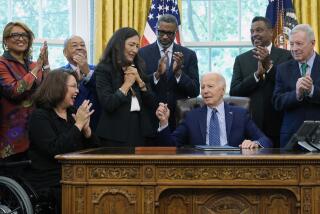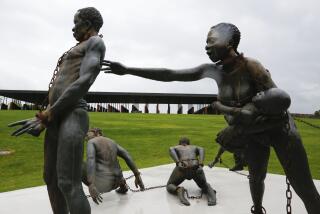Op-Ed: Southern ‘Hanging Bridge: A monument to Judge Lynch
There is a dirt road just north of the small town of Shubuta, in Clarke County, Miss., that seems to lead to nowhere, or at least nowhere anyone might want to go. If you turn onto East Street and follow the northerly bend in the road, you encounter a padlocked gate emblazoned with bright orange “No Trespassing” signs. A few hundred yards farther, at a densely wooded bend in the road, a rusty bridge spans the Chickasawhay River. Between World War I and World War II, white vigilantes lynched six black victims at this spot. There is no historical marker, no memorial; just a rickety span that locals call the Hanging Bridge.
On Feb. 10, the Montgomery, Ala.-based organization Equal Justice Initiative released “Lynching in America,” a searing report that documents 3,959 lynchings in 12 Southern states from 1877 to 1950. The researchers note that their count exceeds that of previous studies by at least 700 victims. The news media seized on the numbers and paid less attention to what the group characterized as an “astonishing absence” of lynching memorials in communities that boast monuments to Confederate soldiers and architects of the South’s Jim Crow regime.
But lynching monuments, of a kind, do exist, like the bridge over the Chickasawhay. It first earned its place in history in 1918, when a mob hanged brothers Major and Andrew Clark and sisters Maggie and Alma Howze — both pregnant — after their white boss turned up dead. When the NAACP, just 10 years old at the time, requested an investigation, Mississippi’s governor told its members to “go to hell.”
Twenty-four years later, in 1942, white vigilantes hanged Ernest Green and Charlie Lang — ages 14 and 15, respectively — for the “attempted rape” of a white girl.
Noting that the bridge’s death toll stood at six, a black journalist branded Shubuta’s Hanging Bridge “a monument to ‘Judge Lynch.’”
In the 1960s, when civil rights workers arrived in Clarke County, the bridge was already a memorial of sorts. One local worker occasionally drove volunteers out to the place “where they hang the negroes.” A former summer volunteer recalled 40-odd years later, “The way he said it, it could have happened a hundred years ago, or last week.”
The Equal Justice Initiative report emphasizes that the trauma of racial terrorism extended far beyond the immediate victims and the immediate moment. Mob violence spurred a variety of black responses, from outmigration to political action. “Lynching in America” notes that Georgia and South Carolina lost more than a fifth of their black population in a single decade. In Clarke County, the 1920 federal census revealed a 30% decline.
Many of those migrants headed to Northern cities, where they tipped the balance of power in urban congressional districts and helped elect Democrats and Republicans who sponsored pioneering civil rights legislation. From anti-lynching crusader Ida B. Wells to NAACP officials to civil rights workers in tiny towns across the South, black freedom fighters credited brushes with the mob and memories of racial violence as an inspiration for activism.
In Shubuta, the fearful relatives of the dead refused to retrieve the lynched corpses from the Hanging Bridge. In 1918 and again in 1942, local officials buried the victims just outside the town’s white cemetery. Inside the cemetery fence stands a 12-foot monument “To Our Confederate Dead.” It casts a shadow on the headstones of a few likely lynch mob members, as well as the unmarked graves of their young victims.
As for the bridge, the highway bypassed it years ago. Then, perhaps for fear that a curiosity seeker might fall through holes in its wood deck, local officials erected the barricade across the old dirt road. When I asked if it might have anything to do with the fact that County Road 215 led to a lynching site, a local explained, “People don’t need to see that.”
The Equal Justice Initiative follows in the long and courageous tradition of activist-scholars who have recognized that lynchings cannot be allowed to fade from our memory. The statistics are crucial and so are the stories behind them. Memorials and markers root those stories in a place and for all time. They do exist, if we tear down the barriers erected to keep us from them.
Jason Morgan Ward is associate professor of history at Mississippi State University. He is the author of “Hanging Bridge: A Lynching Site and a Civil Rights Century,” which will be published next year.
Follow the Opinion section on Twitter @latimesopinion and Facebook
More to Read
A cure for the common opinion
Get thought-provoking perspectives with our weekly newsletter.
You may occasionally receive promotional content from the Los Angeles Times.










